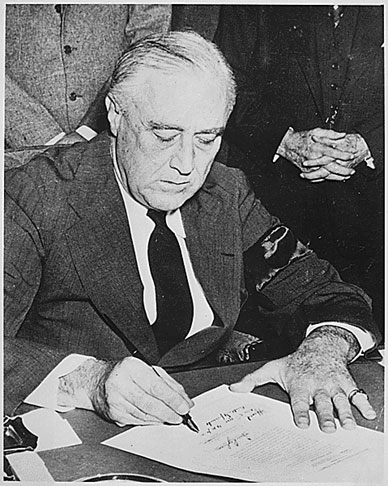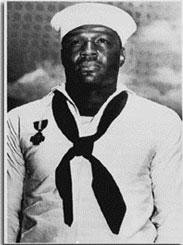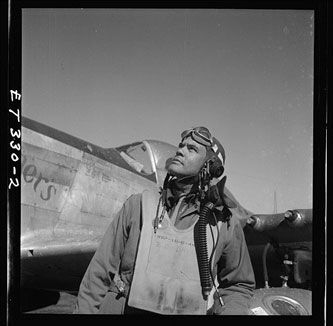The United States Enters World War II
World War II started on September 1, 1939, with the German invasion of Poland. With war already raging in Asia, the invasion sparked a global conflict that lasted until 1945. The Axis Powers fought relentlessly against the Allied Powers for dominance around the world.
The United States remained neutral in the war until Japan, a member of the Axis Powers, attacked an American naval base at Pearl Harbor, Hawaii, on December 7, 1941. In response to the attack and a dramatic speech by President Franklin Delano Roosevelt, the U.S. Congress declared war on Japan on December 8, 1941. Three days later, the United States declared war on Germany and Italy.
The Attack on Pearl Harbor—December 7, 1941
Source: [Pearl Harbor naval base and U.S.S. Shaw aflame after the Japanese attack], Library of Congress
Click on the link below to watch a video about the attack on Pearl Harbor.
President Franklin Roosevelt signs the Declaration of War December 8, 1941
Source: Photo, FDR signing declaration, National Archives
This attack and the subsequent entry into war galvanized all Americans as the nation braced for war. For Americans, the war would be fought abroad and on the home front.
In this lesson, you will identify the social and economic impact of World War II on the American home front.
Mobilizing for War
On December 8, 1941, the United States entered World War II. Immediately, the country was forced to prepare for the effects of the war. The mobilization of the United States in preparation for the war not only involved the military, but it also evolved into a tremendous effort on the part of all Americans.
![]() The graphic below illustrates a few examples of the United States' mobilization during World War II. Click the hotspot to learn more.
The graphic below illustrates a few examples of the United States' mobilization during World War II. Click the hotspot to learn more.
Civilians who did not enlist in the military played a crucial role in the war. As part of an intensive government propaganda campaign, the government encouraged civilians to “Work or Fight.” Civilians were encouraged to work in wartime industries, participate in community-wide wartime activities, and support the armed forces.
The American Home Front: An Economic Impact
During the 1930s, the United States was consumed by the harsh economic crisis of the Great Depression. The economy was plagued by bank failures and high unemployment rates. President Roosevelt’s New Deal economic policies were helping the nation recover from the crisis. By the end of the 1930s, the Great Depression was weakening, but Americans were still hindered by the poverty that the Depression had created.
In Europe, World War II started in 1939 with the German invasion of Poland. Germany invaded neighboring European countries and destroyed lives and property in its wake. Prior to the attack on Pearl Harbor, Roosevelt had promised to stay out of the war, but he wanted to support Britain in its struggle against German aggression.
Great Britain’s prime minister, Winston Churchill, requested Roosevelt’s assistance after sustaining a heavy loss of ships, planes, and other military equipment at the hands of Germany. Churchill asked Roosevelt for supplies to help Great Britain defend itself in the war.
Roosevelt wanted to keep his promise of neutrality, but he also wanted to be able to supply the British with supplies. His solution was the proposal of the Lend-Lease Act.
![]() Click on the document hotspot below to learn more about this act.
Click on the document hotspot below to learn more about this act.
The approval of the Lend-Lease Act shifted the U.S. economy into a wartime economy. Many businesses moved from the production of consumer goods to the production of war supplies and military vehicles. American companies began producing guns, planes, tanks, and other military equipment at an unbelievable rate. As a result, there were more jobs available, and more Americans went back to work.

Source: Poster, Let’s Go get ‘em! U.S. Marines, Library of Congress
Immediately following the attack on Pearl Harbor in 1941, millions of men were called to duty. When these men joined the armed forces, they left behind millions of jobs. Instantly, the nation faced a labor shortage that was filled by workers who had previously been denied many employment opportunities.

Source: Rosie the Riveter, American National Biography Online
Women entered the workforce at an unprecedented rate. More than six million women were a part of the workforce during World War II; for many of them, this was the first time they held jobs outside of the home. Women worked industry jobs that were traditionally held by men. Rosie the Riveter, pictured left, became an iconic figure for American woman. This fictional character represented the contribution of women in the workplace during the war.
During the war, women who worked in war industry jobs were referred to as "Rosies."
The availability of new job opportunities in American factories also attracted African Americans. African Americans migrated to major manufacturing areas in the North as well as in the West. African Americans worked for government wartime agencies as well as war industries. Pictured below are three young men working on the cockpit of an airplane; this is an example of a wartime industry job.

Source: Final assembly of the pilot's compartment is being made by these Negro workers in a large eastern aircraft factory. These youths went directly from a war training course to their jobs in this plant." Howard Liberman, National Archives.
The war also caused a labor shortage in the agricultural industry as many American farmers and farm workers enlisted in the military. In an agreement with Mexico, President Roosevelt created the Bracero Program. The program allowed Mexican laborers to immigrate to the United States temporarily to work on the nation’s farms and ranches. Between 1942 and 1964, more than four million braceros came to the United States under this program.

Source: Bracero Program, Vearthy, Wikimedia
The shift to wartime production helped to end the Great Depression by jump-starting the economy, but the government was still in need of money to fund its involvement in the war. The government created more programs and agencies to support the war effort, which led to more federal employees than the United States had ever employed. The government launched several campaigns that encouraged American civilians to help support the war.
War Bonds

![]() This video is a televised appeal to Americans by Secretary of the Treasury Henry Morgenthau to help fund the war.
This video is a televised appeal to Americans by Secretary of the Treasury Henry Morgenthau to help fund the war.
Rationing
To ensure adequate supplies of raw materials and goods for both military and civilian needs, the government initiated a campaign for rationing in the American home front. Americans were asked to buy only what was necessary and to conserve and recycle what they could. By rationing, everyone got his or her fair share of goods.

Source: FSA 8bO6554, Library of Congress
Each family was issued a war ration book filled with coupons or stamps, which indicated how much of an item could be purchased. Families received books of stamps for items such as meat, butter, sugar, and canned goods.
Fuel was in short supply as it was needed both overseas and at home. Gasoline was rationed, and most cars had a gas ration sticker displayed on the driver window. Drivers were asked to carpool and observe speed limits in order to conserve fuel.
Victory Gardens

Source: War gardens for victory--Grow vitamins at your kitchen door, Library of Congress
Americans also produced their own food by planting victory gardens and canning or preserving what was grown. The victory garden effort garnered more than eight million tons of food for Americans during World War II.
Americans on the home front actively supported the war effort through these activities. Their contributions and sacrifices made a tremendous impact on the war.
Women and Minorities: Contributions and Challenges
 Every aspect of the lives of Americans was affected by the war. There was an increased wave of patriotism immediately following the bombing of Pearl Harbor. Americans from all walks of life participated in acts of patriotism that encapsulated the United States during the war.
Every aspect of the lives of Americans was affected by the war. There was an increased wave of patriotism immediately following the bombing of Pearl Harbor. Americans from all walks of life participated in acts of patriotism that encapsulated the United States during the war.
The Office of War Information managed a campaign to encourage patriotism through a series of posters. Click on the link below for examples of posters from World War II from the U.S. National Archives and Records Administration.
Newspapers and radio programming were geared toward reporting the war and keeping civilians informed. There were songs and movies produced with patriotic themes. Actors, singers, and other entertainers traveled across the country to entertain the troops.

Source: Poster, Poster 133, Minnesota Historical Society
Men and women voluntarily enlisted into the armed forces in record numbers. By the end of the war, there were more than 12 million members of the United States Armed Forces. More than 350,000 women served in the U.S. military and more than 70,000 served as Army and Navy nurses.
In 1942, President Roosevelt created the Women’s Auxiliary Forces, which included branches of the military specifically for women. The following is a list of Women’s Auxiliary Forces:
- Women's Army Auxiliary Corps (WAC or WAAC)
- Women Air Force Service Pilots (WASP)
- Women Accepted for Volunteer Emergency Service (WAVES)
- U.S. Coast Guard Women’s Reserve (nicknamed SPARS)
Women were not allowed to participate in armed conflict, and most women in the military served in roles that were considered traditional female jobs. These jobs included clerks, secretaries, and mail sorters. These positions were important to military functions because they kept the flow of communication moving. Women who served in the medical corps faced more danger because their work was usually performed closer to the front lines.
Although all Americans were working toward a victory in World War II, many of the social problems that plagued the United States also followed American troops to war. At the beginning of the U.S. involvement in the war, the military was segregated. African-American troops lived, worked, and relaxed in separate facilities. They had separate training and were then placed in separate military units, which were led by white officers.
African-American soldiers were frequently assigned to supply units instead of combat. Although these soldiers were discriminated against at home and in the military, they proudly served their country in the war.

An example of such bravery came on the day that the Japanese attacked Pearl Harbor. Doris Miller was a mess attendant (cook) on the U.S.S. West Virginia at the time of the attack. Despite enemy strafing and bombing, Miller helped move his mortally wounded Captain to a place of greater safety. He then manned and fired a machine gun against the attacking Japanese planes until ordered to leave the ship's bridge.
In the African-American community, Miller’s actions were a source of pride. Miller continued his service in the navy until he died when the U.S.S. Liscome Bay was sunk by a Japanese submarine torpedo in 1943.
Source: Doris Miller, National Archives

Source: [Photograph of several Tuskegee airmen at Ramitelli, Italy, March 1945], Tony Frisell, Library of Congress
During the time that most African American soldiers were relegated to duties such as cooking and cleaning, a heroic group of African Americans known as the Tuskegee Airmen emerged. The Tuskegee Airmen was a group of specially trained African-American combat pilots who studied at Tuskegee Institute in Tuskegee, Alabama. The Tuskegee Airmen were assigned the task of escorting American bomber planes flying missions over enemy territory in Europe.

Source: Col. Benjamin O. Davis, air base at Rametti, Italy, Toni Frissell, Library of Congress
Colonel Benjamin O. Davis commanded the Tuskegee Airmen. In combat over Europe, they shot down more than 100 enemy planes without losing one of the American bombers they escorted. Davis would later become the first African-American general in the U.S. Air Force.
While segregation persisted in the armed forces, some change came on the home front. A. Philip Randolph, an African-American labor leader, presented President Roosevelt with a list of grievances regarding the civil rights of African-American workers in the nation’s defense industry. Randolph planned a huge protest march in Washington, D.C., if the demands were not met. Fearing such a protest would undermine wartime unity, President Roosevelt issued Executive Order 8802, banning discriminatory employment practices by Federal agencies and all unions and companies engaged in war-related work. Click on the link below to view a video about A. Philip Randolph and the March on Washington Movement.
![]()
Source: WWII & NYC: March on Washington, New York Historical Society, YouTube

Source: Navajo Code Talkers, Bradipus, Wikimedia
A special group of American Indians called the Navajo Code Talkers was another group that made an important contribution to World War II. The Navajo Indians were recruited to transmit and receive secretly coded radio communications for the U.S. Marines. This was essential because enemy forces intercepted and listened to radio transmissions pertaining to Marine maneuvers and combat.
The Navajo Code Talkers developed a secret code of communication based on the Navajo language. The enemy was unable to decode the Navajo language, thus making the Navajo Code Talkers essential to the success of the Allies during World War II.
Over 500,000 Latinos (including 350,000 Mexican Americans) served in World War II. Unlike African Americans, they were not segregated into separate units. Latino soldiers who were fluent in Spanish served an important role in fighting in the Philippines. Their knowledge of Spanish was invaluable when serving with Spanish speaking Filipinos. In Europe, Latino soldiers from the 36th Infantry Division from Texas were among the first soldiers to land in Italy. Seventeen Medals of Honor have been awarded to Latinos for service during World War II.
While women and minorities were making contributions to the war overseas and at home, they still faced the obstacles of a country that continued to foster inequality and discrimination. Click on the image hotspots below to learn more about the struggles of some of the ethnic minorities in the United States.
Lesson Summary
Upon entry into World War II, the United States was charged with fighting a multi-front war. The United States Armed Forces fought in both the European and Pacific Theaters, while American civilians supported the war from the American home front.
Those on the home front supported the war in many ways. Men and women enlisted in the military in record numbers. Americans showed their patriotism by supporting the victory programs created by government agencies.
The wartime economy presented women and minorities with new job opportunities. Although the war presented Americans with new opportunities, American society was still plagued by social issues such as racial tensions and discrimination.